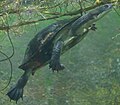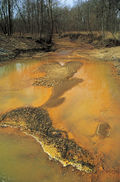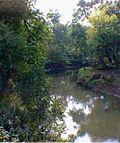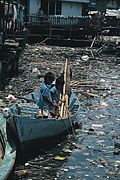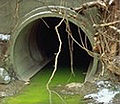AY Honors/Environmental Conservation/Answer Key
Template:Honor header Template:AY Master
1. What is the difference between ecology and environmental conservation?
- Ecology
- Is defined as "the study of how organisms interact with each other and their physical environment."
- Environmental conservation
- Is defined as "the rational use of the environment to provide the highest sustainable quality of living for humanity."
2. Write a 500 word essay on how the increase in human population is threatening our existence on earth.
The most important threat to our existence on earth today is that of global warming. The human activity that has the greatest effect on warming is the release of greenhouse gases such as C02. For your research into this issue, see the following Wikipedia articles:
Other factors include Overpopulation and Deforestation. Can you think of others?
3. What does the term “death” of a lake or river mean? Is there a lake or river in your area or country which is classified as “dead”?
The death of a lake or river is said to occur when it becomes so polluted that it can no longer support life (such as fish, turtles, crustaceans, etc). The most famous dead river is probably the Cuyahoga River in Ohio which actually caught on fire many times, helping to spur the environmental movement in the late 1960s.
Fires plagued the Cuyahoga beginning in 1936 when a spark from a blow torch ignited floating debris and oils. Fires erupted on the river several more times before June 22, 1969, when a river fire captured the attention of Time magazine, which described the Cuyahoga as the river that "oozes rather than flows" and in which a person "does not drown but decays."
This event helped spur an avalanche of pollution control activities resulting in the Clean Water Act, Great Lakes Water Quality Agreement, and the creation of the federal and state Environmental Protection Agency. As a result, large point sources of pollution on the Cuyahoga have received significant attention from the Ohio Environmental Protection Agency in recent decades.
Water quality has improved and, in recognition of this improvement, the Cuyahoga River was designated as one of 14 American Heritage Rivers in 1998. Pollution remains, however, including nonpoint source problems, Combined Sewer Overflows (CSOs), and stagnation due to water impounded by dams. For this reason, the Environmental Protection Agency classified portions of the Cuyahoga River Watershed as one of 43 Great Lakes Areas of Concern.
4. Carry out a stream investigation of a small stream flowing through or near your home town. Check for the following:
a. Signs of Purity
- Minnow up close2.jpg
(1) Abundance of small fish present
b. Signs of Stream Deterioration and Death
5. If your stream is showing some of the above signs of death, do something about cleaning it up. Contact the closest government agency to ask what you and/or your group can do to help improve the stream. Organize a group of young people to help in cleaning the trash along your stream. If possible, get businesses to help in your campaign.
In the United States, environmental protection is managed by the government at all levels: local, state, and federal. It will be much easier to contact local or state officials rather than federal officials. Check the phone directory under "Environmental Protection" or search the Internet to find contact information for the agency in your area. If you are having difficulty finding the government body responsible for this in your area, try contacting a local paddling club, The American Canoe Association, or American Whitewater. These associations have a vested interest in clean rivers and streams (that's their playground!) and often organize river clean-up projects. They will be able to get you on a project, put you in touch with the most responsive government body, and recommend local businesses that are responsive to environmental conservation.




